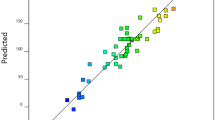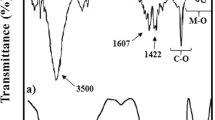Abstract
Dual responsive composite hydrogels were successfully prepared by combining cellulose nanofibril (CNF) isolated by 2,2,6,6-tetramethylpiperidine-1-oxyl radical (TEMPO)-mediated oxidation with thermally responsive poly(N-isopropylacrylamide) (PNIPAAm) for drug release at 10 wt% CNF loading and − 20 °C polymerization temperature. pH responsive hydrogels were acquired by adjusting the carboxyl charge level of the CNF during TEMPO-mediated oxidation. CNF–PNIPAAm hydrogels fabricated were characterized in regards to compressive strength, functional group, low critical solution temperature (LCST), and swelling ratio of the hydrogels at different temperatures from 20 to 60 °C and pH levels from 2 to 10. Finally, the drug release behavior of these hydrogels was also investigated using methylene blue as a model drug. As the carboxylate content increases, the dual responsiveness of hydrogel improved at the expense of the compression strength. The CNF–PNIPAAm hydrogels were swollen and translucent below the LCST, and shrunken and opaque above the LCST. The Higuchi and the Krosmeyer and Peppas model was best-fitted to the drug release behavior of these hydrogels at pH 10 and pH 2, respectively. The results also indicated that a proper selection of polymerization temperature provided a way of tuning the dual-responsiveness of the hydrogels. These results also suggest that the CNF–PNIPAAm hydrogels can release drugs on demand.









Similar content being viewed by others
References
Aixiang Q, Mangeng L, Qunfeng L, ** Z (2007) Synthesis and characterization of thermo-sensitive poly(N-isopropylacrylamide) hydrogel with fast response rate. Front Chem China 2:135–139
Azetsu A, Koga H, Isogai A, Kitaoka T (2011) Synthesis and catalytic features of hybrid metal nanoparticles supported on cellulose nanofibers. Catalyst 1:83–96
Barazzouk S, Daneault C (2012) Tryptophan-based peptides grafted onto oxidized nanocellulose. Cellulose 19:481–493
Benhamou K, Dufresne A, Magnin A, Mortha G, Kaddami H (2014) Control of size and viscoelastic properties of nanofibrillated cellulose from palm tree by varying the TEMPO-mediated oxidation time. Carbohydr Polym 99:74–83
Besbes I, Alila S, Boufi S (2011) Nanofibrillated cellulose TEMPO-oxidized eucalyptus fibres: effect of the carboxyl content. Carbohydr Polym 84:975–983
Cha RT, He ZB, Ni Y (2012) Preparation and characterization of thermal/pH-sensitive hydrogel from carboxylated nanocrystalline cellulose. Carbohydr Polym 88:713–718
Coseri S, Biliuta G, Simionescu BC, Stana-Kleinschek K, Ribitsch V, Harabagiu V (2013) Oxidized cellulose—survey of the most recent achievements. Carbohydr Polym 93:207–215
Dong H, Snyder JF, Williams KS, Andzelm JW (2013) Cation induced hydrogels of cellulose nanofibrils with tunable moduli. Biomacromol 14:3338–3345
Feil H, Bae YH, Feijen J, Kim SW (1993) Effect of comonomer hydrophilicity and ionization on the lower critical solution temperature of N-isopropylacrylamide copolymers. Macromolecules 26:2496–2500
Fujisawa S, Ikeuchi T, Takeuchi M, Saito T, Isogai A (2012) Superior reinforcement effect of TEMPO-oxidized cellulose nanofibrils in polystyrene matrix: optical, thermal and mechanical studies. Biomacromol 13:2188–2194
Fukuzumi H, Saito T, Okita Y, Isogai A (2010) Thermal stabilization of TEMPO-oxidized cellulose. Polym Degrad Stab 95:1502–1508
Haqani M, Roghani-Mamaqani H, Salami-Kalajahi M (2017) Synthesis of dual-sensitive nanocrystalline cellulose-grafted block copolymers of N-isopropylacrylamide and acrylic acid by reversible addition–fragmentation chain transfer polymerization. Cellulose 24:2241–2254
Hebeish A, Farag S, Sharaf S, Shaheen ThI (2014) Thermal responsive hydrogels based on semi interpenetrating network of poly(NIPAm) and cellulose nanowhiskers. Carbohydr Polym 102:159–166
Hebeish A, Farag S, Sharaf S, Shaheen ThI (2015) Radically new cellulose nanocomposite hydrogels: temperature and pH responsive characters. Carbohydr Polym 81:356–361
Isogai A, Saito T, Fukuzumi H (2011) TEMPO-oxidized cellulose nanofibers. Nanoscale 3:71–85
Jiang Y, Wu Y, Huo Y (2015) Thermo-responsive hydrogels with N-isopropylacrylamide/acrylamide interpenetrating networks for controlled drug release. J Biomater Sci Polym Ed 26:917–930
Lasseuguette E (2008) Grafting onto microfibrils of native cellulose. Cellulose 15:571–580
Lasseuguette E, Roux D, Nishiyama Y (2008) Rheological properties of microfibrillar suspension of TEMPO-oxidized pulp. Cellulose 15:425–433
Lee SC, Kwon IK, Park K (2013) Hydrogels for delivery of bioactive agents: a historical perspective. Adv Drug Deliv Rev 65:17–20
Lee KY, Aitomaki Y, Berglund LA, Oksman K, Bismarck A (2014) On the use of nanocellulose as reinforcement in polymer matric composites. Compos Sci Technol 105:15–27
Liu HL, Liu MZ, Ma LW, Chen J (2009) Thermo- and pH-sensitive comb-type grafted poly(N,N-diethyacrylamide-co-acrylic acid) hydrogels with rapid response behaviors. Eur Polym J 45:2060–2067
Masruchin N, Park BD (2015) Manipulation of surface carboxyl content on TEMPO-oxidized cellulose fibrils. J Korean Wood Sci Technol 43:613–627
Masruchin N, Park BD, Causin V (2015a) Influence of sonication treatment on supramolecular cellulose microfibril-based hydrogels induced by ionic interaction. J Ind Eng Chem 29:265–272
Masruchin N, Park BD, Causin V, Um IC (2015b) Characteristic of TEMPO-oxidized cellulose fibril-based hydrogels induced by cationic ions and their properties. Cellulose 22:1993–2010
Peng Y, Gardner DJ, Hang Y (2012) Drying cellulose nanofibrils: in search of a suitable method. Cellulose 19:91–102
Saito T, Uematsu T, Kimura S, Enomae T, Isogai A (2011) Self-aligned integration of native cellulose nanofibrils towards producing diverse bulk materials. Soft Matter 7:8804–8809
Sanna R, Fortunati E, Alzari V, Nuvoli D, Terenzi A, Casula MF, Kenny JM, Mariani A (2013) Poly(N-vinylcaprolactam) nanocomposites containing nanocrystalline cellulose: a green approach to thermoresponsive hydrogels. Cellulose 20:2393–2402
Santos JR, Alves NM, Mano JF (2010) New thermo-responsive hydrogels based on poly(N-isopropylacrylamide)/hyaluronic acid semi-interpenetrated polymer networks: swelling properties and drug release studies. J Bioact Compat Polym 25:169–184
Sun XF, Wang HH, **g ZX, Mohanathas R (2013) Hemicellulose-based pH-sensitive and biodegradable hydrogel for controlled drug delivery. Carbohydr Polym 92:1357–1366
Sun XF, Ye Q, **g ZX, Li Y (2014) Preparation of hemicelluloses-g-poly(methacrylic acid)/carbon nanotube composite hydrogel and adsorption properties. Polym Compos 35:45–52
Sun XF, Gan Z, **g ZX, Wang HH, Wang D, ** Y (2015) Adsorption of methylene blue on hemicellulose-based stimuli-responsive porous hydrogel. J Appl Polym Sci 132:41606
Tejado A, Alam MdN, Antal M, Yang H, van de Ven TGM (2012) Energy requirements for the disintegration of cellulose fibers into cellulose nanofibers. Cellulose 19:831–842
Wang J, Zhou XS, **ao HN (2013) Structure and properties of cellulose/poly(N-isopropylacrylamide) hydrogels prepared by SIPN strategy. Carbohydr Polym 94:749–754
Wei J, Chen Y, Liu H, Du C, Yu H, Ru J, Zhou Z (2016a) Effect of surface charge content in the TEMPO-oxidized cellulose nanofibers on morphologies and properties of poly(N-isopropylacrylamide)-based composite hydrogels. Ind Crops Prod 92:227–235
Wei J, Chen Y, Liu H, Du C, Yu H, Zhou Z (2016b) Thermo-responsive and compression properties of TEMPO-oxidized cellulose nanofiber-modified PNIPAm hydrogels. Carbohydr Polym 147:201–207
**ao XC (2007) Effect of the initiator on thermosensitive rate of poly(N-isopropylacrylamide) hydrogels. eXPRESS Polym Lett 4:232–235
Xu X, Liu F, Jiang L, Zhu JY, Haagenson D, Wiesenborn DP (2013) Cellulose nanocrystals vs cellulose nanofibrils: a comparative study on their microstructures and effects as polymer reinforcing agents. ACS Appl Mater Interfaces 5:2999–3009
Zhang ZX, Zhuo RX (2000) Synthesis of temperature-sensitive poly(N-isopropylacrylamide) hydrogel with improved surface property. J Colloid Interface Sci 223:311–313
Zhang ZX, Wu DQ, Chu CC (2003) Effect of the crosslinking level on the properties of temperature-sensitive poly(N-isopropylacrylamide) hydrogels. J Polym Sci Part B Polym Phys 41:582–593
Zhang ZX, Wu DQ, Chu CC (2004) Synthesis, characterization and controlled drug release of thermosensitive IPN–PNIPAAm hydrogels. Biomaterials 25:3793–3805
Zhang ZX, Xu XD, Cheng SX, Zhuo RX (2008) Strategies to improve the response rate of thermosensitive PNIPAAm hydrogels. Soft Matter 4:385–391
Zhang F, Wu W, Zhang X, Meng X, Tong G, Deng Y (2016) Temperature-sensitive poly-NIPAm modified cellulose nanofibril cryogel microspheres for controlled drug release. Cellulose 23:415–425
Zhang H, Yang M, Luan Q, Tang H, Huang F, **ang X, Yang C, Bao Y (2017) Cellulose anionic hydrogels based on cellulose nanofibers as natural stimulants for seed germination and seedling growth. J Agric Food Chem 65:3785–3791
Acknowledgments
This work was financially supported by Joint Research Program through the National Research Foundation (NRF) of Korea and funded by the Ministry of Education, Science and Technology (Grant No: 2016K1A3A1A12953690).
Author information
Authors and Affiliations
Corresponding author
Ethics declarations
Conflict of interest
The authors declare that they have no conflict of interest.
Electronic supplementary material
Below is the link to the electronic supplementary material.
Rights and permissions
About this article
Cite this article
Masruchin, N., Park, BD. & Causin, V. Dual-responsive composite hydrogels based on TEMPO-oxidized cellulose nanofibril and poly(N-isopropylacrylamide) for model drug release. Cellulose 25, 485–502 (2018). https://doi.org/10.1007/s10570-017-1585-2
Received:
Accepted:
Published:
Issue Date:
DOI: https://doi.org/10.1007/s10570-017-1585-2




